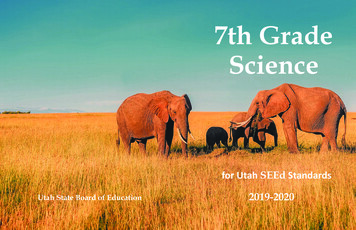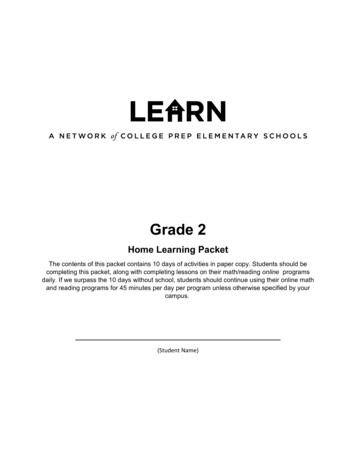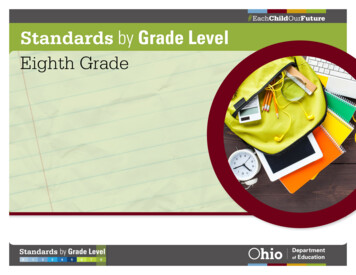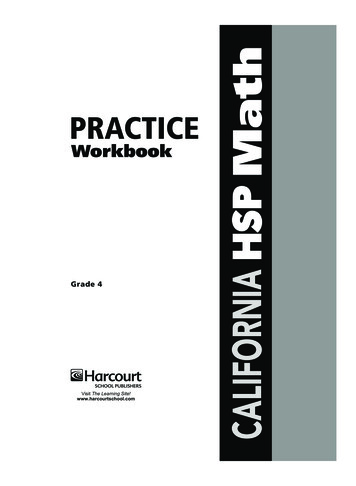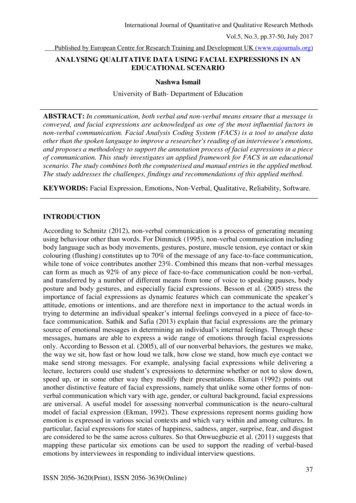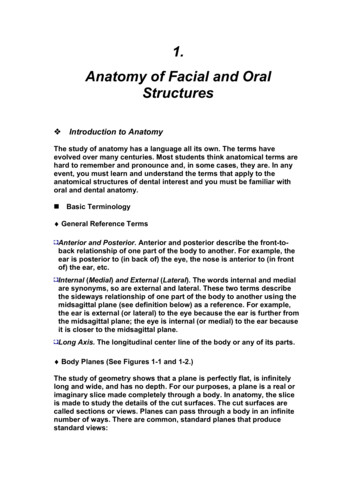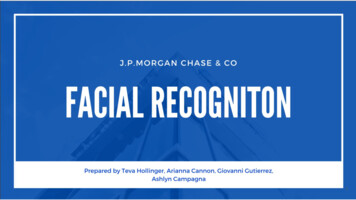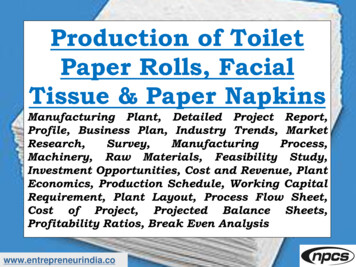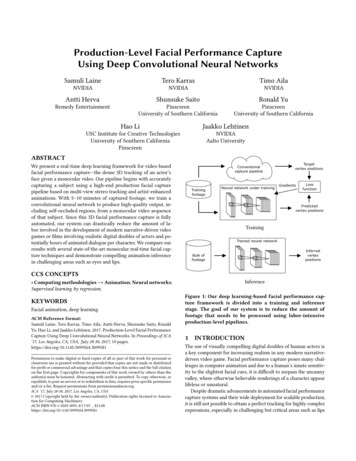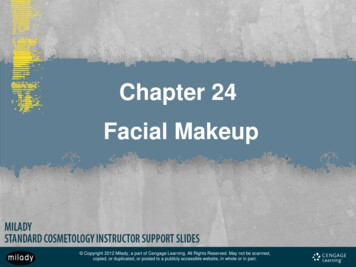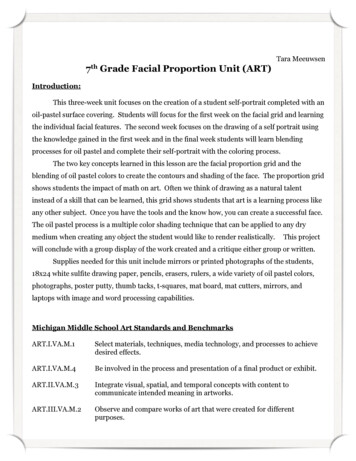
Transcription
Tara Meeuwsen7thGrade Facial Proportion Unit (ART)Introduction:This three-week unit focuses on the creation of a student self-portrait completed with anoil-pastel surface covering. Students will focus for the first week on the facial grid and learningthe individual facial features. The second week focuses on the drawing of a self portrait usingthe knowledge gained in the first week and in the final week students will learn blendingprocesses for oil pastel and complete their self-portrait with the coloring process.The two key concepts learned in this lesson are the facial proportion grid and theblending of oil pastel colors to create the contours and shading of the face. The proportion gridshows students the impact of math on art. Often we think of drawing as a natural talentinstead of a skill that can be learned, this grid shows students that art is a learning process likeany other subject. Once you have the tools and the know how, you can create a successful face.The oil pastel process is a multiple color shading technique that can be applied to any drymedium when creating any object the student would like to render realistically.This projectwill conclude with a group display of the work created and a critique either group or written.Supplies needed for this unit include mirrors or printed photographs of the students,18x24 white sulfite drawing paper, pencils, erasers, rulers, a wide variety of oil pastel colors,photographs, poster putty, thumb tacks, t-squares, mat board, mat cutters, mirrors, andlaptops with image and word processing capabilities.Michigan Middle School Art Standards and BenchmarksART.I.VA.M.1Select materials, techniques, media technology, and processes to achievedesired effects.ART.I.VA.M.4Be involved in the process and presentation of a final product or exhibit.ART.II.VA.M.3Integrate visual, spatial, and temporal concepts with content tocommunicate intended meaning in artworks.ART.III.VA.M.2Observe and compare works of art that were created for differentpurposes.
ART.III.VA.M.4Describe and compare the characteristics of personal artwork to theartwork of others.ART.III.VA.M.5Describe how personal experiences influence the development of specificartworksART.V.VA.M.4Describe ways in which the principles and subject matter of otherdisciplines taught in the school are interrelated with the visual artUnit Objectives:As a result of this unit, the students will know: The ratios used for ideal human facial proportion.The individual piece needed for each facial feature.The basic bone structure of the human face.The structure of a group critique.As a result of this unit, the students will understand: How to draw the facial proportion grid.How to draw each individual facial feature.How to use layered oil pastels to create a visual sense of contour and depth,As a result of this unit, the students will be able to: (I can .) Create a realistic self-portrait.Shade effectively to show visual depth.Discuss art-work in a group critique.
As a Result of this unit students will be able to:I CAN.Talk about the artwork of the Renaissance and identifykey artist and paintings from this time period.Use math ratios and proportions to grid the human face.Create all the facial features (eyes, nose, mouth, ears,hair, neck) in realistic detail, and I understand how toadjust these features to create emotions.Talk about Abstract artwork and identify keymovements thought Abstract art and important artists.Use math ratios and proportions to grid the humanbody.Create realistic landscapes and background images.Blend using oil pastels to give my images shading anddepth.Present my artwork in a variety of way and understandhow different presentations of my work will effectpeople’s understandings of my artwork.Critically discuss my own work and the work of mypeers.As a Result of this unit student will create:I will make:A realistic self portrait with a unique background.
7th Grade Self-Portraits UnitLessonWhole Lesson # 1Keywords: Portrait and Self Portraitneed to be explained and discussed asa group and the Key-Words andDefinitions added to the studentsVocab-lists. (5 mins)IntroductionBlind Contour Drawing:Blind Contour DrawingandPre-Assessment Drawing1 Class Period (50 Minutes)A Blind Contour Drawing is adrawing done only looking at thesubject. The artist may not look downat the paper and they may not fix orerase any part of the drawing. Thisactivity will be done with a parter.One person draws first while theirpartner models and then they switchroles. This helps us learn how muchtime we need to spend looking at ourmodel or subject when drawing.(15 mins)Pre Assessment Drawing:Students will create a Pre-LessonDrawing to see how well they arecurrently drawing portraits. Theywill also complete the followingsentences on the back of theirdrawing: I am good at drawing. Ineed help with.(30 mins)We will be using color partners(Complements) established in aprevious lesson. (See SupplementalMaterial)
LessonWhole Lesson # 2Art HistoryRenaissance1 Day Lecture1 Day ActivityIn Analogous Color Groups studentswill discuss what they already knowabout the renaissance.Keynote Lecture On Renaissance.Lecture will be shown on the projectorand communicated aloud, but thepresentation and abbreviated noteswill be available for students onMoodle.Students will need to take notes onkey artists and painting (See attachedSheet)There are fill in the blank notes forstudents who struggle with notetaking (See attached Sheet)Exit Card: Students must list one coolfact about the Renaissance or aRenaissance ArtistDay 2Profiler See Attached MaterialLessonWhole Lesson # 3Facial Grid1 classStudents will begin by taking aphotograph of themselves with photobooth and printing it so that it can beused to aid their facial grid nots. .Notes:Students will be taking take notesfrom the board about the facial gridand then also drawing the grid overtheir photograph of their face so thatthey can see how practical the grid fitsto them.Tiered Assignment using the facialgrid
LessonLesson # 4Whole ClassComponentDifferentiatedComponentReview Facial Grid: Students will becalled on to come to the board anddraw one line of the facial grid untilwe have a completed grid to start theday.5 minsFacial FeaturesNotes on Drawing the Facial Feature:1 dayStudents will take notes on the facialfeatures we will be drawing them,writing about them and measuringthem on our own faces to reenforcethis knowledge.There will be a fill in the blank notefor students who are struggling.Test your knowledge ActivityTic Tac Toe (see attached sheet)LessonWhole Lesson #5Art HistoryCubism and the Abstracts1 day lecture1 day SACIn Primary Color Groups studentswill try to answer the question: Whywould you want to create an abstractpainting instead of a realistic one?5minsKeynote Lecture On 20th CenturyAbstract and Cubist Portraits.Lecture will be shown on the projectorand communicated aloud, but thepresentation and abbreviated noteswill be available for students onMoodle. 45minsStudents will need to take notes onkey artists and painting (See attachedSheet)There are fill in the blank notes forstudents who struggle with notetaking (See attached Sheet)Exit Card: Students must tell what istheir favorite Abstract Painting andWhy? 5minStructured Academic ControversyDay 2 (See attached material)
LessonWhole ClassComponentDifferentiatedComponentInto:Lesson #6The Human BodyProportionWorking with Complementary ColorPartners students will measure howbig their head is and then how tallthey are to see the ratio of how tallthey are.Students will take notes on full bodyproportion using the 7 head model.There will be fill in the black notesavailable for those students whostruggle with note taking.Anchor Activity: Using theirknowledge of both the face and thehuman body students will create a selfportrait on a sheet of 18x 24 drawingpaper, they can work from a mirror orfrom a photograph and they maychoose to create a head only or a fullbody portrait depending on what theyfeel most confident in creating.1 day notes2 days drawingIndependent study for students doneearly: Photo Strips see attached sheetLessonLesson # 7Filling the BackgroundSpace Landscapes2 daysWhole ClassComponentDifferentiatedComponentAs a class we will be reviewing theconcepts of horizon line and vanishingpoints that students learned in 6thgrade. We will also be discussing thevarious landscapes and backgroundswe saw in the art history lectures.Anchor Activity:Students will create a landscape to fillin the background of their large 18x 24drawing, Backgrounds may be real orimaginary.
LessonWhole ClassComponentDifferentiatedComponentDemoLesson #8Students will watch teacherdemonstrate how to blend oil pastelsto create values and shadows.Oil Pastel BlendingAnchor Activity Students will use theblending knowledge to create a shortone day free drawing from CUBESHEET see attached Material1 day Practice3 days coloringLessonLesson #9Hanging and Presenting thework1 dayStudents will then use oil pastel tocolor their 18x24 drawing.Students who are struggling withpastels or who are behind may usecolored pencil to simplify the project.Whole ClassComponentDifferentiatedComponentIn Color Wheel groups students willdiscuss the best way to hang up the artwork, the best location in school and atitle for the exhibit. Then all groupswill share their plan and students willvote on the best way to display theart.Once a display is decided on allstudents will help in hanging andframing artwork.Trimind Assignment for homework.
LessonWhole Lesson # 10Critique Both Self andClass1 dayTeacher will give a quick reminder ofwhat is a critique and how it helpsartistes improve.Oral Class critique:Class will go to where artwork isdisplayed and then we will take turnsdiscussing each piece of art and bothwhat we like about the project andhow it could have been improved.Written Self CritiqueUsing the Raft model students willwrite a self critique to finish theproject.Completed Unit is 18 day, or two and a half school weeks.
Facial Proportion Unit PlanLesson #1 Blind Contour and Pre-Assessment Drawings!Differentiated Components are indicated with an asterisk *Agenda (1 - 50 min class period)!Introduction (5 mins)!!The key-words Portrait and Self Portrait will be!!explained and discussed as a class. Definitions will!!be written on the white-board and students will copy these definitions on to their!!Art Vocabulary list. Portrait- A picture of a person Self-Portrait- A of you created!!by you.!Blind Contour Drawings (15 mins)!!Blind Contour Drawing will be explained to the class as a drawing done by only!!looking at the subject or a drawing done with out looking down at the paper!!while the artist is working. The artist may not erase or fix any part of the!!drawing. This drawing is not about creating a ‘good‘ looking image, instead it is!!an activity that assists students in switching from using the Left Brain to using!!their Right Brain. It also shows students that they draw better when looking at!!their subject then the do when they trust their brains to tell them what they are!!seeing. We will be doing this activity in Pairs using our Complementary Color!!Partners* (see attached sheet). The older partner in the pair group will draw first!!and the younger partner modeling for 5-6 mins then students will switch and!!continue to draw for another 5-6 mins. (I have planned 10-12 minutes of drawing!!but have allowed 15 mins for this activity because most students will want to take!!time to show and compare work so time needs to be allowed for this.)!Pre-Assessment Drawings (30 mins)*!!All students will create a Pre-Assessment drawing to show what level they are!!currently drawing at. They will have 20 minutes to create their drawing and may
!!have the option of drawing from a memory a photograph or a mirror. With 5!!minutes left in class students will be asked to complete the following sentences on!!the back of their art work. I am good at drawing. I need help with.in my!!drawing. This will let me know what students think are their strong and weak!!points in drawing portraits. It also gives us a point to compare their progress!!through-out the unit to. It is important that both myself and the student can see!!their growth. This is the Exit Card.Materials!Paper, Pencils, Erasers and Mirrors.
Color Wheel PartnersYour ColorYellow PartnerOrange PartnerRed PartnerViolet PartnerBlue PartnerGreen PartnerFill in the name of a friend who was given one of the color cards above. We will be using this sheetall semester to form color groups to do work in class so it is important to keep this sheet in your artfolder all semester. You should know you Color Schemes well enough to form you group with outhelp but just incase there is a reminder below of some of our Color Schemes.Primary Colors- Red, Blue and YellowSecondary Colors- Green, Orange and PurpleComplementary- 2 colors accost the color wheel from each otherAnalogous Colors- 3 Colors in a row on the color wheelMonochromatic- 1 color plus all it’s tints and shades (meaning you are on your own for this project)
Facial Proportion Unit PlanLesson #2 Art History Lecture on Portraits of the Renaissance!Differentiated Components are indicated with an asterisk *Agenda (2 - 50 min class periods)!Introduction (10 mins )!!In Analogous Color Groups students will discuss!!what they already know about the Renaissance!!Period in art history. Students should have some!!background knowledge from both 6th grade History and Elementary Art.!!Students will have 10 minutes to come up with 5 facts they know to be true about!!the Renaissance that could be culture, paintings or specific artists. This wi
currently drawing portraits. They will also complete the following sentences on the back of their drawing: I am good at drawing. I need help with. (30 mins) 7th Grade Self-Portraits Unit. Lesson Whole Class Component Differentiated Component Lesson # 2 Art History Renaissance 1 Day Lecture 1 Day Activity Introduction: In Analogous Color Groups students will discuss what they already know .
